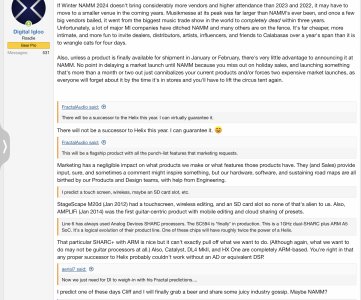I actually really care about gapless switching. Here's my reasoning.
With snapshots/scenes, I need to think more. I need to think about how I need to approach my presets in the context of a live show. For live shows I know a few things:
1. I don't want to have to switch my amp channel and my effects individually too much.
2. I don't want to have any gaps of silence in the middle of a song that don't belong there.
3. I want to have my delays and reverbs trailing off nicely from section to section.
4. In between songs, I don't want there to be lots of dead air whilst the band gets their gear queued up for the right patches, tempos, etc.
5. I don't want to have to bank up/down in the middle of a song to find the next sound.
6. I don't want to have to switch between modes in the middle of a song.
Mostly in a song I want to only have to do two things:
1. Choose a "sound" which is a combination of amp channel and effects.
2. Tap my tempo whilst playing along with the drummer, to resync all my delays to his organic drifting tempo.
So.... with these caveats in action, some things clearly become obvious:
1. 8 snapshots is never enough for even 1 song. I've compromised on my live tones and my accuracy to the way the songs should sound, in favour of an easier life. But from memory, I recall most songs requiring 10 and above different sounds. Some of these I can get with an expression pedal. But most of them need to be a dedicated switch.
2. Because I'm not too accurate with my feet, hitting the Helix "mode" switch always feels like a faff to me. I've accidentally muted myself during a few rehearsals before, and I've also accidentally changed my tempo before, because whilst singing, I can't hit that switch accurately enough.
3. Currently I have a preset per-song. But if I suddenly decide I need to change my reverb mix, or add in a noise gate, or tweak a thing, I now need to update 10+ presets. Axe FX addresses this a bit with global blocks, but still...
3. I really struggle to read the scribble strips on Helix because of my shitty eyes. I take my glasses off for live performance because I want to be able to feel the music and headbang. And given that my snapshots are different from preset to preset (they have to be, because slightly different tones) the scribble strips are near useless to me. (The FC12 strips are a LOT easier to read with blurry eyes as it goes!!) - So I can't rely on reading them.
All that is to say that my setup for the live shows, as good as it has been, has always been a compromise. True gapless presets and proper spillover would really help me reduce those compromises as much as possible. Because instead of each song needing 10+ scenes, forcing me to reduce it to 8 and change the type of effects I use and how they're dialled in....
... I could just quite simply have a collection of presets, and switch between them whatever song I happen to be playing. Because quite a lot of the songs use common sounds, with an additional 1 or 2 unique ones for that particular song.
Which is all to say.... this is why I'm considering moving over to Axe III as my effects unit, along with the FC12, so that I can just have 12 presets at my feet at any given time.
So that is my reasoning for wanting gapless preset changes complete with proper spillover. If you only ever use 4 basic tones, then I can totally see why it wouldn't be important to you.
Also, to add... this is why something like the GigRig G3 is so attractive. 14 switches at your feet, so you could have 12 presets at your feet as well as a tap switch, and a tuner switch... or tap and bank up... or bank up and bank down. It is very nice and configurable!


